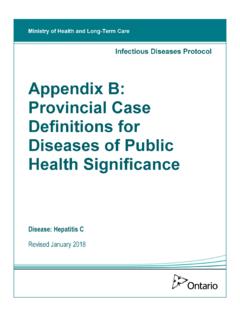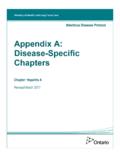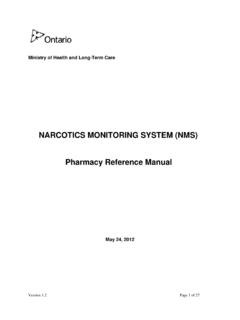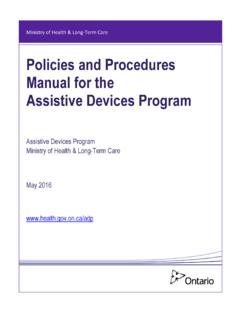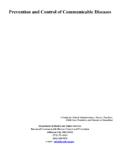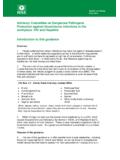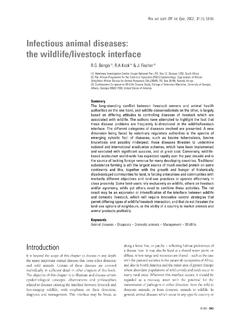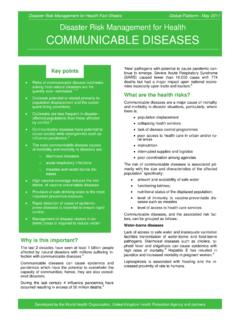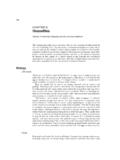Transcription of Infectious Diseases Protocol, 2018
1 Ministry of Health and Long-Term Care Infectious Diseases Protocol, 2018 Population and Public Health Division, Ministry of Health and Long-Term Care Effective: January 1, 2018 or upon date of releaseInfectious Diseases Protocol, 2018 2 Preamble The Ontario Public Health Standards: Requirements for Programs, Services, and Accountability (Standards) are published by the Minister of Health and Long-Term Care under the authority of section 7 of the Health Protection and Promotion Act (HPPA) to specify the mandatory health programs and services provided by boards of ,2 The Standards identify the minimum expectations for public health programs and services. Boards of health are accountable for implementing the Standards including the protocols and guidelines that are referenced in the Standards. Protocols are program and topic-specific documents incorporated into the Standards which provide direction on how boards of health shall operationalize specific requirement(s) identified within the Standards.
2 Pur pose The purpose of this protocol is to provide direction to boards of health with respect to the prevention, detection and management of Infectious Diseases of public health importance. This protocol should be considered as an overarching protocol to support the other Infectious disease and infection prevention related protocols and disease -specific appendices, and should be utilized in conjunction with the Population Health Assessment and Surveillance Protocol, 2018 (or as current), where This protocol is intended to provide direction regarding minimum responsibilities for analyzing, interpreting, responding to, and communicating about Infectious disease events to reduce the burden of Infectious Diseases of public health importance. This protocol is also intended to ensure emergency service workers (ESWs) are notified by the medical officer of health, or designate, in the event that s/he may have been exposed to an Infectious disease of public health importance so that appropriate action can be taken.
3 The protocol provides direction regarding: The establishment of rates of Infectious Diseases of public health importance and factors that influence their occurrence; The identification of emerging trends and changes in Infectious disease rates; The identification of trends and changes in factors that influence the rate of Infectious Diseases ; The provision of timely communications with respect to Infectious disease incidence rates that are above expected rates; The assessment of population health status with respect to Infectious Diseases ; The planning of evidence-based public health policies, programs, interventions and services to prevent, detect and control Infectious Diseases in the community and in high-risk settings; The evaluation of public health policies, programs, interventions and services related to the prevention and control of Infectious Diseases ; and, Infectious Diseases Protocol, 2018 3 The responsibilities of boards of health with regard to notifying ESWs of possible exposures to Infectious Diseases of public health importance where: o Diseases are not limited to those named under the Mandatory Blood Testing Act, 2006 (MBTA) (currently restricted to hepatitis B, hepatitis C and HIV/AIDS.)
4 ;4 or o An ESW has not made an application under the MBTA, but the board of health and/or medical officer of health or designate suspects that an ESW may have been exposed to an Infectious disease of public health importance. Appendix A, disease Specific Chapters, provides information on the pathogenicity, epidemiology and public health management of all Infectious disease of public health significance in Ontario. Appendix B, Provincial Case Definitions, provides the provincial surveillance case definitions for Infectious disease of public health significance, in addition to disease -specific information, including current laboratory technologies and clinical signs and symptoms. Further direction, with respect to sexually transmitted infections, rabies and tuberculosis prevention and control can also be found in the Sexual Health and Sexually Transmitted/Blood-Borne Infections Prevention and Control Protocol, 2018 (or as current); the Rabies Prevention and Control Protocol, 2018 (or as current); and the Tuberculosis Prevention and Control Protocol, 2018 (or as current).
5 5-7 This protocol does not address requirements of boards of health under the MBTA which is administered by the Ministry of Community Safety and Correctional to the Standards This section identifies the standards and requirements to which this protocol relates. Population Health Assessment Requirement 2. The board of health shall interpret and use surveillance data to communicate information on risks to relevant audiences in accordance with the Healthy Environments and Climate Change Guideline, 2018 (or as current); the Infectious Diseases Protocol, 2018 (or as current); and the Population Health Assessment and Surveillance Protocol, 2018 (or as current). Food Safety Requirement 5. The board of health shall ensure 24/7 availability to receive reports of and respond to: a) Suspected and confirmed food-borne illnesses or outbreaks; b) Unsafe food-handling practices, food recalls, adulteration, and consumer complaints; and c) Food-related issues arising from floods, fires, power outages, or other situations that may affect food safety in accordance with the Health Protection and Promotion Act; Infectious Diseases Protocol, 2018 4 the Food Safety Protocol, 2018 (or as current); the Infectious Diseases Protocol, 2018 (or as current); and the Operational Approaches for Food Safety Guideline, 2018 (or as current).
6 Healthy Environments Requirement 1. The board of health shall: a) Conduct surveillance of environmental factors in the community; b) Conduct epidemiological analysis of surveillance data including monitoring of trends over time; emerging trends; and priority populations; and c) Use information obtained to inform healthy environments programs and services in accordance with the Health Hazard Response Protocol, 2018 (or as current); the Healthy Environments and Climate Change Guideline, 2018 (or as current); the Infectious Diseases Protocol, 2018 (or as current); and the Population Health Assessment and Surveillance Protocol, 2018 (or as current). Immunization Requirement 1. The board of health shall, in accordance with the Immunization for Children in Schools and Licensed Child Care Settings Protocol, 2018 (or as current), assess, maintain records and report on: a) The immunization status of children enrolled in licensed child care settings, as defined in the Child Care and Early Years Act, 2014;8 b) The immunization status of children attending schools in accordance with the Immunization of School Pupils Act; and c) Immunizations administered at board of health-based clinics as required in accordance with the Immunization for Children in Schools and Licensed Child Care Settings Protocol, 2018 (or as current) and the Infectious Diseases Protocol, 2018 (or as current).
7 Requirement 2. The board of health shall conduct epidemiological analysis of surveillance data for vaccine preventable Diseases , vaccine coverage, and adverse events following immunization, including monitoring of trends over time, emerging trends and priority populations in accordance with the Infectious Diseases Protocol, 2018 (or as current) and the Population Health Assessment and Surveillance Protocol, 2018 (or as current). Requirement 10. The board of health shall: a) Promote reporting of adverse events following immunization by health care providers to the local board of health in accordance with the Health Protection and Promotion Act; and b) Monitor, investigate, and document all suspected cases of adverse events following immunization that meet the provincial reporting criteria and promptly report all cases. Infectious Diseases Protocol, 2018 5 Infectious and Communicable Diseases Prevention and Control Requirement 1.
8 The board of health shall conduct population health assessment and surveillance regarding Infectious and communicable Diseases and their determinants. These efforts shall include: a) Reporting data elements in accordance with the Health Protection and Promotion Act; the Infectious Diseases Protocol, 2018 (or as current); the Rabies Prevention and Control Protocol, 2018 (or as current); the Sexual Health and Sexually Transmitted/Blood-Borne Infections Prevention and Control Protocol, 2018 (or as current); and the Tuberculosis Prevention and Control Protocol, 2018 (or as current); b) Conducting surveillance and epidemiological analysis, including the monitoring of trends over time, emerging trends, and priority populations in accordance with the Infectious Diseases Protocol, 2018 (or as current); the Population Health Assessment and Surveillance Protocol, 2018 (or as current); the Rabies Prevention and Control Protocol, 2018 (or as current).
9 The Sexual Health and Sexually Transmitted/Blood-Borne Infections Prevention and Control Protocol, 2018 (or as current); and the Tuberculosis Prevention and Control Protocol, 2018 (or as current); c) Responding to international, Federal/Provincial/Territorial and local changes in Diseases epidemiology by adapting programs and services; and d) Using the information obtained through assessment and surveillance to inform program development regarding communicable Diseases and other Infectious Diseases of public health importance. Requirement 11. The board of health shall provide public health management of cases, contacts, and outbreaks to minimize the public health risk in accordance with the Infectious Diseases Protocol, 2018 (or as current); the Institutional/Facility Outbreak Management Protocol, 2018 (or as current); the Management of Potential Rabies Exposures Guideline, 2018 (or as current); the Rabies Prevention and Control Protocol, 2018 (or as current); the Sexual Health and Sexually Transmitted/ Blood-Borne Infections Prevention and Control Protocol, 2018 (or as current); and the Tuberculosis Prevention and Control Protocol, 2018 (or as current).
10 Requirement 16. The board of health shall develop a local vector-borne management strategy based on surveillance data and emerging trends in accordance with the Infectious Diseases Protocol, 2018 (or as current). Requirement 21. The board of health shall ensure 24/7 availability to receive reports of and respond to: a) Infectious Diseases of public health importance in accordance with the Health Prot ection and Promotion Act; the Mandatory Blood Testing Act, 2006; the Infectious Diseases Protocol, 2018 (or as current); and the Institutional/ Facility Outbreak Management Protocol, 2018 (or as current); Infectious Diseases Protocol, 2018 6 b) Potential rabies exposures in accordance with the Health Protection and Promotion Act; the Management of Potential Rabies Exposures Guideline, 2018 (or as current); and the Rabies Prevention and Control Protocol, 2018 (or as current); and c) Animal cases of avian chlamydiosis, avian influenza, novel influenza, or Echinococcus multilocularis infection, in accordance with the Health Protection and Promotion Act, the Management of Avian Chlamydiosis in Birds Guideline, 2018 (or as current); the Management of Avian Influenza or Novel Influenza in Birds or Animals Guideline, 2018 (or as current); and the Management of Echinococcus Multilocularis Infections in Animals Guideline, 2018 (or as current).
